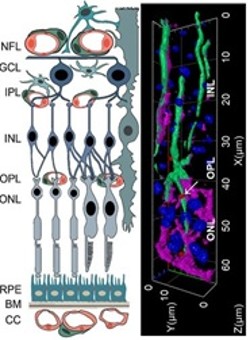AG Braunger “Vascular Growth and Glial Interaction in Retinal Development and Pathology”
In this project we focus on the mechanisms governing vascular development in the retina, both under physiological and pathological conditions such as retinopathy of prematurity (ROP). We investigate how key signaling pathways, including TGF-β (Transforming Growth Factor β) and VEGF (Vascular Endothelial Growth Factor), coordinate the formation, maintenance, and remodeling of the retinal vasculature. Moreover, we explore the interplay between vascular cells and glial cells, aiming to understand how glia contribute to vascular patterning and stability during normal retinal development and in disease.
AG Braunger “Retinal neuroprotection on a cell-type specific level”
In this project we investigate cell-type specific neuroprotective mechanisms in the retina, with a particular focus on diseases such as the dry form of age-related macular degeneration (AMD) and retinitis pigmentosa. We currently aim to understand how signaling pathways such as TGF-β (Transforming Growth Factor β) and Endothelin contribute to maintaining neuronal survival and retinal homeostasis on a cell type specific level in models mimicking degenerative conditions. By analyzing these pathways across distinct retinal cell types, we aim to reveal how their specific signaling determine neuroprotection with the overall aim to get insights that may guide the development of targeted treatments for retinal degeneration.
AG Schlecht: Immunovascular interaction in retinal diseases - from bench to bedside
We investigate the molecular and cellular mechanisms underlying neovascular eye diseases, such as age-related macular degeneration (AMD) or diabetic retinopathy. Although significant therapeutic advances have been made in recent years, these conditions remain incurable, largely due to an incomplete understanding of their molecular basis. We focus on immunovascular interactions, particularly the role of myeloid cells such as microglia and macrophages in regulating pathological angiogenesis in the eye. By integrating molecular and translational approaches, we aim to uncover mechanisms driving disease progression and identify novel therapeutic targets for curative interventions.
AG Dillinger: “Shaping Vision: CCN2/CTGF and the Regulation of the Extracellular Space in Retinal Pathophysiology”
My research focuses on understanding the mechanisms by which regulation of the extracellular space contributes to retinal pathophysiology. A central aspect of this work is the characterization of Cellular communication network factor/Connective Tissue Growth Factor (CCN2/CTGF) as a key mediator linking cell communication, extracellular matrix remodeling, and inflammatory response. By dissecting the molecular and cellular pathways through which CCN2/CTGF influences retinal integrity, I aim to identify novel therapeutic targets for vascular and degenerative retinopathies.
